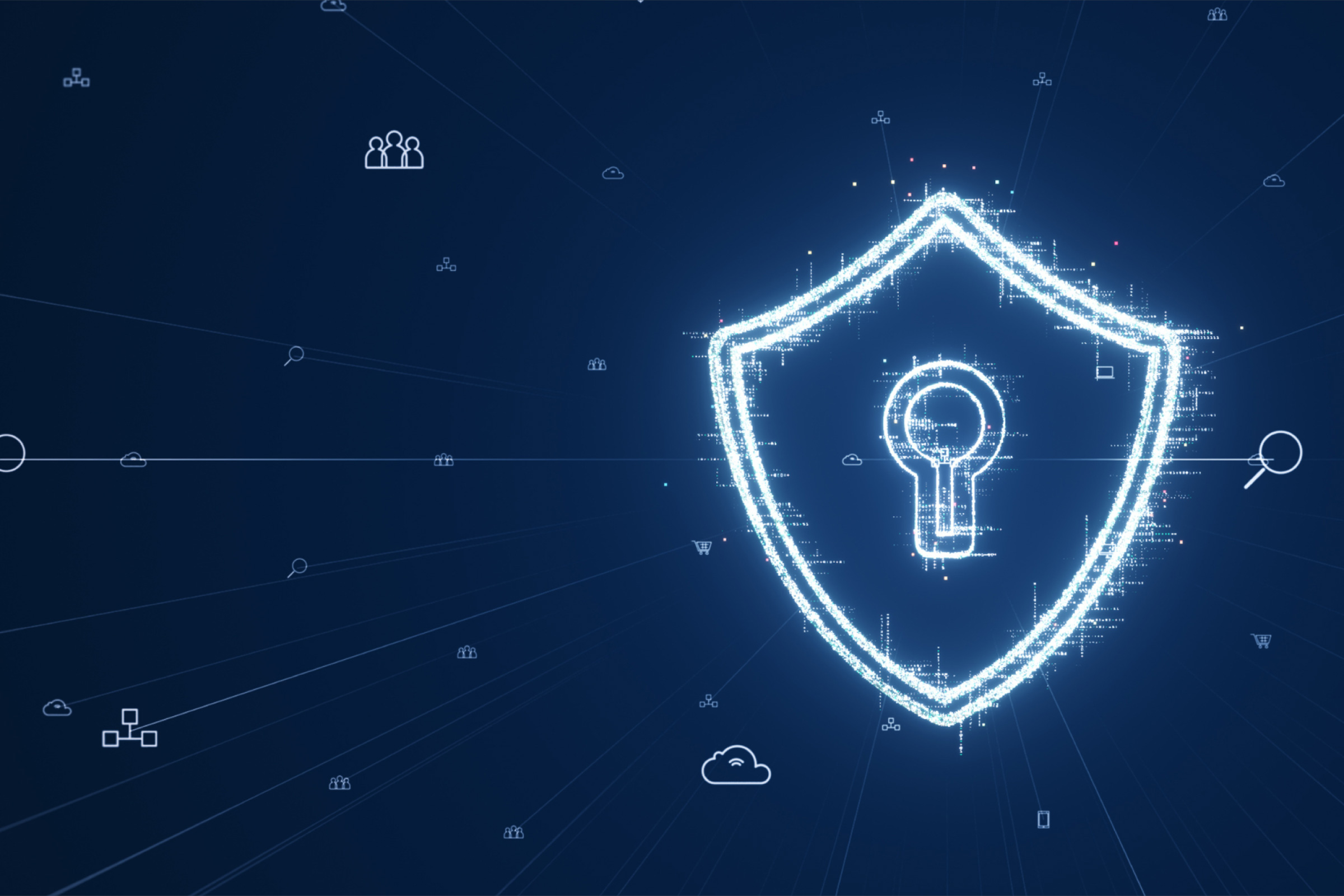What Is Cloud Security?
Cloud security refers to the discipline of protecting cloud-based infrastructure, applications, and data from internal and external threats. It includes a set of technologies, controls, processes, and best practices that work together to ensure the confidentiality, integrity, and availability of cloud resources.
Unlike traditional IT environments, cloud security operates under a shared responsibility model. The cloud provider is responsible for securing the infrastructure, while customers must secure what they deploy in the cloud—such as applications, data, and access policies. The division of responsibilities varies depending on the cloud service model (IaaS, PaaS, or SaaS).
Cloud security strategies often incorporate identity and access management (IAM), data encryption, workload protection, and continuous monitoring. These are supported by tools such as security information and event management (SIEM), cloud-native firewalls, and endpoint protection. Security should also be automated and integrated with CI/CD pipelines.
This is part of a series of articles about information security.
Common Security Threats in Cloud Computing
There are several factors that often contribute to security threats in cloud environments.
Cloud Misconfigurations
Cloud misconfigurations occur when cloud settings are incorrectly set by users, leading to vulnerabilities. Common misconfigurations include improperly set permissions and exposed data storage buckets. Such errors can expose sensitive data to unauthorized access and compromise system integrity. The dynamic nature of cloud environments often complicates security management, increasing the likelihood of these mistakes.
To address this, automated tools can scan configurations and alert administrators to discrepancies. Regular audits are crucial to rectify misconfigurations promptly. Many cases of data exposure in the cloud can be traced back to oversight or lack of compliance with best practices.
Data Breaches
Data breaches in the cloud often stem from weak access controls, vulnerabilities in software, and inadequate monitoring. Such breaches can lead to the exposure of personal and sensitive information, causing damage to organizations and their customers. In cloud environments, the interconnectedness and shared resources increase the impact of any single intrusion.
Preventing data breaches requires implementing access management, encryption, and continuous monitoring. Since cloud environments are constantly evolving, these measures need updating to address new and emerging threats. Additionally, educating employees about phishing and social engineering can prevent credential-based breaches.
Data Loss
Data loss in cloud environments occurs due to accidental deletion, ransomware attacks, or natural disasters. Unlike on-premises solutions, cloud data might not be directly retrievable without backups. Cloud providers typically offer redundancy and failover mechanisms, but sole reliance on them can be risky. Organizations must have robust data backup strategies to ensure continuity and availability.
Implementing a data backup and recovery plan can mitigate data loss risks. Regular testing of backup processes ensures that data can be recovered during incidents. Deploying version control and maintaining copies of critical data in different geographic locations improves recovery resilience.
Account Hijacking
Account hijacking involves gaining unauthorized access to user accounts in the cloud, often through phishing or credential theft. Once the attacker gains control, sensitive data can be accessed, and malicious activities can be carried out. Methods like multifactor authentication (MFA) reduce the risk of account hijacking but require proper implementation and user compliance.
To combat account hijacking, organizations must go beyond basic password security. Incorporating MFA provides an additional layer beyond passwords, improving protection. Monitoring account activities and unusual access patterns can help identify potential compromises early.
Insecure Interfaces and APIs
APIs are essential for cloud services, allowing interaction between applications. However, insecure APIs can be entry points for attackers. Poorly designed APIs can expose data or enable unauthorized access to cloud resources. The complexity of APIs, if not managed properly, can lead to vulnerabilities that are difficult to detect and exploit. Securing APIs involves adopting strong authentication and authorization mechanisms.
Implementing rate limiting, encryption, and regular security testing further improves their security. Developers must adhere to secure coding practices. API gateways can provide central control and monitoring, ensuring consistent security policies are applied across all interfaces.
Denial of Service (DoS) Attacks
Denial of Service (DoS) attacks involve overwhelming a service to render it unavailable to legitimate users. In cloud environments, these attacks can become amplified due to the scalability nature of cloud resources, making it easier to exhaust resources. Cloud providers may mitigate these attacks by offering distributed denial of service (DDoS) protection services, helping to absorb and manage traffic flow.
To counter DoS attacks, organizations should implement rate limiting and traffic filtering to block malicious requests. Utilizing cloud-native security tools can prevent and respond to such attacks efficiently. Contractual security provisions from cloud providers must include DDoS mitigation capabilities.
Malicious Insiders
Malicious insiders pose a threat from within the organization, leveraging authorized access to cause harm or steal data. Cloud environments can exacerbate this risk due to extensive data access across services and locations. Without proper monitoring, identifying malicious activity can be challenging until damage is done.
Implementing stringent access controls and regular activity audits help detect abnormal actions indicative of insider threats. Companies should apply the principle of least privilege, giving users only necessary permissions. Logging and monitoring can alert administrators to suspicious behaviors, allowing timely intervention.
Cloud Security Across Different Providers
Cloud Security on AWS
Amazon Web Services (AWS) is one of the largest and most widely adopted cloud platforms, offering a set of global services including compute, storage, networking, and databases. AWS’s approach to security is built on a shared responsibility model, where AWS manages the security of the cloud infrastructure, and customers manage security in the cloud.
AWS provides the following security tools and services:
- Identity and Access Management (IAM) for granular permission control
- AWS Shield for DDoS protection
- Amazon GuardDuty for threat detection and continuous monitoring
- Encryption at rest and in transit using AWS Key Management Service (KMS)
- Virtual Private Cloud (VPC) for network isolation
- Security groups and network ACLs for traffic filtering
Cloud Security on Azure
Microsoft Azure is a cloud computing platform offering services for analytics, virtual computing, storage, and networking. Known for its integration with Microsoft’s enterprise ecosystem, Azure emphasizes security through a layered approach and provides tools to protect identities, data, and workloads.
Azure provides the following security tools and services:
- Azure Active Directory (AD) for identity and access management
- Azure Security Center for unified threat protection and compliance
- Azure Key Vault for secure key and secret management
- Network Security Groups (NSGs) for traffic control
- Azure Firewall for centralized traffic inspection and filtering
- Encryption for data at rest and in transit
Cloud Security on Google Cloud
Google Cloud delivers a suite of cloud services backed by Google’s global infrastructure. It focuses on delivering security through custom-built infrastructure, secure-by-default services, and advanced threat intelligence.
Google Cloud provides the following security tools and services:
- Identity and Access Management (IAM) with fine-grained role controls
- Encryption by default with support for customer-managed and supplied keys
- Security Command Center for visibility into risks and threats
- Google Cloud Armor for DDoS defense and web application protection
- VPC Service Controls to prevent data exfiltration
- Custom hardware security using Google’s Titan chips
Cloud Security on Other Cloud Providers
Beyond the major players, most other cloud providers offer specialized cloud security features tailored to use cases or industries:
- IBM Cloud integrates security across its hybrid and multicloud environments, leveraging its heritage in enterprise IT. Key features include IBM Cloud Security Advisor for risk identification, data encryption with IBM Key Protect, and support for confidential computing using secure enclaves. IBM emphasizes regulatory compliance, supporting standards like FIPS 140-2 and HIPAA.
- Oracle Cloud Infrastructure (OCI) emphasizes built-in security and database protection. OCI offers services such as Oracle Identity Cloud Service for identity management, Data Safe for database security assessment, and Vault for encryption key management. Its architecture separates network and compute resources for improved isolation.
- Alibaba Cloud, dominant in the Asia-Pacific region, provides services like Anti-DDoS Pro, Web Application Firewall (WAF), and ActionTrail for activity auditing. It offers encryption tools and adheres to compliance standards such as ISO 27001 and China’s Cybersecurity Law, making it a strong choice for organizations operating in China.
Key Technologies Supporting Cloud Security
Multi-Factor Authentication
Multi-Factor Authentication (MFA) improves security by requiring multiple verification methods before granting access. Typically involving something you know (password) and something you have (a code sent to a device), MFA protects against unauthorized access.
MFA’s adoption can be simplified with tools that simplify user experience without compromising security. Organizations should ensure systems support MFA and educate users about its use and purpose. Effective implementation involves selecting the right MFA option that balances security needs with usability.
Identity and Access Management
Identity and Access Management (IAM) involves processes and tools to manage digital identities and control access to resources. It is fundamental in cloud environments, ensuring that only authorized users can access data and applications. By implementing IAM, organizations can reduce insider threats and improve compliance.
IAM systems automate the onboarding and offboarding of users, granting and revoking access as roles change. This automation ensures a swift response to security needs, maintaining a secure access protocol. Combining IAM with policies like least privilege helps prevent unauthorized access.
Cloud Firewalls
Firewalls are crucial in monitoring and controlling incoming and outgoing network traffic based on security rules. They form a foundational element in cloud security architectures, preventing unauthorized access while allowing legitimate communication. In the cloud, deploying cloud-native firewalls effectively guards workloads and applications from various threats.
Cloud firewalls allow dynamic adaptation to network changes, scaling automatically with cloud infrastructure. Their integration into cloud environments enables centralized management of security policies, improving network defense measures. Implementing effective firewall rules requires understanding application communication needs, ensuring they enforce security without hindering legitimate traffic.
Intrusion Detection and Prevention Systems
Intrusion Detection and Prevention Systems (IDPS) monitor cloud environments for suspicious activities, identifying and responding to threats. These systems deploy rule-based and anomaly-based detection techniques to identify potential security breaches. The real-time nature of IDPS ensures swift actions against detected threats, minimizing potential damage.
In the cloud, IDPS solutions often integrate seamlessly with other security measures, improving overall security posture. Configuring IDPS appropriately to balance sensitivity and noise is crucial, avoiding alarm fatigue while staying vigilant against legitimate threats. Regular review and refinement of detection strategies ensure IDPS remains effective against evolving attack vectors.
Exposure Management
Exposure management refers to the continuous process of identifying, evaluating, and reducing an organization’s attack surface across its cloud environments. Unlike traditional vulnerability management, which focuses on known software flaws, exposure management looks at how assets—such as misconfigured services, public-facing endpoints, and unused identities—can be exploited in real-world attack scenarios.
Effective exposure management combines asset discovery, contextual risk assessment, and attack path analysis. Tools should automatically inventory cloud resources, classify them by sensitivity, and detect changes such as new internet-exposed services or privilege escalations.
Security Information and Event Management
Security Information and Event Management (SIEM) systems provide security visibility by aggregating and analyzing security data from across the cloud infrastructure. SIEM is integral for detecting, responding, and investigating incidents, offering insight into cloud security. Advanced analytics and machine learning improve SIEM’s capacity to identify emerging threats.
Deploying SIEM requires integration with existing security tools, enabling consolidated monitoring and alerting. The automation of threat detection and incident response simplifies operations, reducing response time to potential threats. SIEM’s centralized approach aids compliance efforts, maintaining detailed logs essential for audits and investigations.
Endpoint Protection
Endpoint protection secures devices connected to the cloud, covering laptops, smartphones, and tablets. By protecting endpoints, organizations reduce the risk of data breaches stemming from device-based attacks. Endpoint protection integrates antivirus, anti-malware, and other security measures to ensure device security.
Incorporating endpoint protection involves consistent software updates and patches to guard against vulnerabilities. Organizations should deploy solutions that offer real-time threat detection and endpoint visibility, ensuring defense coverage. Training users on secure practices and recognizing suspicious activities further bolster endpoint security.
Tips from the Expert

Rob Gurzeev, CEO and Co-Founder of CyCognito, has led the development of offensive security solutions for both the private sector and intelligence agencies.
In my experience, here are tips that can help you better strengthen cloud security beyond what’s already covered:
- Use temporary, short-lived credentials everywhere possible: Replace long-lived API keys or IAM credentials with ephemeral tokens via services like AWS STS or Google Workload Identity Federation. Short-lived credentials reduce the window of opportunity for attackers, especially in compromised environments or CI/CD pipelines.
- Implement cloud honeypots to detect lateral movement or insider threats: Deploy decoy resources—fake storage buckets, API endpoints, or IAM roles—to detect unauthorized access attempts. These traps provide early warning of internal misuse or post-breach activity that may bypass traditional defenses.
- Secure cloud CI/CD pipelines as a priority: Pipelines often have excessive privileges and act as attackers’ shortcuts to production. Rotate secrets regularly, limit pipeline IAM roles, and isolate build environments. Consider signing artifacts and enforcing integrity validation before deployments.
- Conduct cross-region and cross-account visibility audits: In multi-region or multi-account cloud environments, threats often hide in areas with little oversight. Aggregate logs centrally and perform threat hunting across regions/accounts to catch misconfigured or forgotten assets.
- Validate encryption at the application layer—not just infrastructure: While cloud providers handle encryption at rest/transit, sensitive workloads should also encrypt data at the application level. This ensures encryption keys and logic stay under the organization’s control and protects against insider threats or cloud provider breaches.
Types of Cloud Security Solutions
CSPM (Cloud Security Posture Management)
Cloud Security Posture Management (CSPM) tools provide automated assessment and remediation of cloud security configurations, ensuring compliance with best practices and regulatory requirements. CSPM focuses on identifying and resolving configuration issues that could lead to security incidents in cloud environments, offering insights into security posture.
CSPM solutions continuously monitor environments, alerting administrators to deviations from configured security baselines. By providing detailed reports, they enable quick identification and resolution of compliance gaps. CSPM acts as a control for organizations prioritizing cloud security, enabling regular audits and promoting improved security postures.
External Attack Surface Management (EASM)
External Attack Surface Management (EASM) focuses on discovering, inventorying, and managing internet-facing assets that an organization may not be fully aware of or control. In cloud environments, the proliferation of assets — due to decentralized teams, shadow IT, or third-party integrations — makes it easy for services to become exposed without oversight.
EASM solutions continuously scan the internet to identify domains, subdomains, IP addresses, APIs, cloud storage, and services associated with an organization. They correlate data across DNS records, certificates, and cloud configurations to map the organization’s external footprint. Once discovered, assets are assessed for risk, such as open ports or outdated software.
CWPP (Cloud Workload Protection Platform)
Cloud Workload Protection Platforms (CWPPs) protect workloads across cloud environments, addressing threats in SaaS, PaaS, and IaaS models. CWPPs provide insights into application activity, enabling the identification of anomalous behaviors that signal potential security incidents. These platforms help maintain the integrity of diverse cloud workloads.
CWPP solutions often integrate seamlessly into cloud environments, enabling consistent security policy enforcement. They support proactive threat management by alerting administrators to vulnerabilities and offering remediation insights. Effective CWPP deployment involves understanding workload-specific requirements to align security policies with organizational goals and regulatory standards.
CASB (Cloud Access Security Broker)
Cloud Access Security Brokers (CASBs) mediate between cloud service users and providers, delivering visibility and control over cloud service use. CASBs extend security policies from on-premises infrastructure to the cloud, ensuring alignment with organizational security standards. They provide mechanisms for enforcing data protection policies, managing access, and gaining insights into cloud usage patterns.
The adoption of CASB helps organizations manage risks associated with shadow IT, where employees use unauthorized cloud services. By discovering and managing these services, CASBs ensure organizational security policies are adhered to, reducing potential exposure. With built-in data loss prevention and encryption capabilities, CASBs secure sensitive information across cloud applications.
CIEM (Cloud Infrastructure Entitlement Management)
Cloud Infrastructure Entitlement Management (CIEM) tools manage identities and entitlements across cloud environments. They help organizations mitigate risks by controlling over-provisioned cloud identities and enforcing the principle of least privilege. By offering insights into permissions and access rights, CIEM improves security and compliance management.
Deploying CIEM involves integrating with existing identity management systems to simplify entitlement processes. Automated provisioning and de-provisioning of access rights prevent unnecessary exposure, reducing insider threats. CIEM provides an overview of identity relationships, which is crucial for managing complex, multi-cloud implementations.
CNAPP (Cloud-Native Application Protection Platform)
Cloud-Native Application Protection Platforms (CNAPPs) secure cloud-native applications at runtime, providing visibility and threat protection across containers and serverless workloads. CNAPP solutions unify security management, simplifying protection efforts for dynamic environments. They offer insights into security threats related to development and deployment processes.
CNAPPs are designed to integrate easily with CI/CD pipelines, enabling continuous security assessment during development phases. By protecting applications throughout their lifecycle, CNAPPs ensure vulnerabilities are addressed before exploitation.
Challenges in Cloud Security
Compliance and Legal Issues
Compliance and legal challenges in cloud security arise from various regulations governing data protection, privacy, and how data is handled and stored. Each region may impose distinct regulations, complicating compliance efforts for organizations operating in multiple jurisdictions. Cloud providers must enable adherence to these laws, ensuring that data practices align with regional requirements.
Data Residency and Sovereignty
Data residency and sovereignty present challenges concerning where data is stored and which laws govern it. When data crosses borders, it may be subject to multiple legal frameworks, complicating compliance. Organizations must carefully assess their cloud provider’s data center locations and understand regional regulations impacting data residency decisions.
Shared Responsibility Model
The shared responsibility model defines the division of security responsibilities between cloud providers and users. Understanding this model is crucial for ensuring complete security coverage, avoiding misunderstandings about which party is responsible for security tasks within the cloud environment. Each provider’s model may differ, making familiarity with service-specific divisions necessary.
Lack of Visibility
Lack of visibility in cloud environments can lead to undetected anomalies and vulnerabilities. As organizations adopt multi-cloud strategies, centralized visibility becomes challenging, increasing the risk of security incidents. Tools that aggregate and analyze cloud activities across environments provide insights for managing security.
Learn more in our detailed guide to cloud security challenges.
5 Best Practices for Securing Your Cloud
Here are some of the ways that organizations can overcome common security challenges in the cloud and ensure a safe cloud environment.
1. Regularly Monitor and Audit Configurations
Regular monitoring and auditing of cloud configurations are essential for identifying misconfigurations, unauthorized changes, and compliance issues. Many security breaches occur due to improperly configured services, such as open storage buckets or permissive firewall rules.
Organizations should implement automated tools—such as CSPM platforms—that continuously assess cloud configurations against established baselines and compliance frameworks like CIS, NIST, or ISO. These tools can generate alerts for deviations and offer actionable remediation guidance. Logging configuration changes through infrastructure-as-code (IaC) tools like Terraform or AWS CloudFormation provides version control and audit trails, making it easier to trace issues back to specific changes.
Monitoring should extend to user activity and API calls. Services like AWS CloudTrail, Azure Activity Logs, or Google Cloud Audit Logs enable visibility into operational actions and configuration changes. Scheduled reviews and audit reports ensure ongoing compliance and reduce the attack surface caused by configuration drift.
2. Encrypt Data Both in Transit and at Rest
Encryption is a core security measure for ensuring data confidentiality and integrity. Data at rest—stored in object storage, databases, or volumes—must be encrypted to prevent unauthorized access in case of breaches. Encryption in transit protects data from eavesdropping or tampering during transmission between services, clients, and users.
Most cloud providers support server-side encryption by default and offer key management systems (e.g., AWS KMS, Azure Key Vault, or Google Cloud KMS) for managing encryption keys. Using customer-managed keys or even customer-supplied keys gives organizations greater control over encryption operations. Transport Layer Security (TLS) must be enforced for all external and internal communications.
It’s critical to implement consistent encryption policies across services and environments. This includes verifying that backups, logs, and temporary files are encrypted. Monitoring key usage, setting expiration and rotation schedules, and restricting access to key management operations are necessary to maintain a strong encryption strategy.
3. Conduct Regular Vulnerability Assessments and Penetration Testing
Routine vulnerability assessments help uncover security flaws in applications, operating systems, containers, and configurations. These scans can detect unpatched software, misconfigured services, or exposed APIs. Regular assessments are vital due to the dynamic nature of cloud environments, where assets can be rapidly provisioned or decommissioned.
Organizations should deploy vulnerability management tools such as Qualys, Tenable, or native cloud services like Amazon Inspector to automatically scan infrastructure. Integrating these tools into CI/CD pipelines ensures new deployments are vetted for vulnerabilities before reaching production.
Penetration testing goes further by simulating real-world attack scenarios to test the effectiveness of security controls. Tests should cover internal and external entry points, identity and access policies, and application logic. When performing tests on cloud platforms, organizations must adhere to provider guidelines and obtain necessary approvals to avoid service disruption.
4. Develop and Test an Incident Response Plan
A reliable incident response plan (IRP) is critical for effectively managing security incidents, minimizing damage, and restoring services. In cloud environments, incident response must account for the distributed and ephemeral nature of resources, where affected systems may disappear or auto-scale before investigation is complete.
An IRP should define clear steps for detection, containment, investigation, eradication, recovery, and post-incident review. It should specify roles and responsibilities for incident handlers, communication channels (including legal and PR), and escalation paths. Logs and telemetry data from tools like SIEM, endpoint detection, and cloud-native services (e.g., AWS GuardDuty, Azure Sentinel) should be centralized and retained for forensic analysis.
Testing the IRP through regular tabletop exercises or simulated attacks ensures that team members understand procedures and can act quickly. Gaps discovered during simulations should be documented and addressed to refine the response process. The plan should also include playbooks for common incidents such as credential theft, malware outbreaks, or DDoS attacks.
5. Monitor and Manage Your External Attack Surface
Managing the external attack surface involves identifying all internet-facing assets and continuously monitoring them for vulnerabilities and misconfigurations. Organizations should adopt External Attack Surface Management (EASM) tools to automate the discovery of exposed assets.
Monitoring should cover assets spun up by CI/CD pipelines, abandoned development environments, and inherited domains from mergers. Once assets are identified, continuous assessment is critical. Security teams must scan for open ports, outdated software, default credentials, or improperly configured access controls.
Risk should be prioritized based on exploitability and business impact, enabling faster remediation of high-value targets. Establishing ownership for every discovered asset ensures accountability. Combining EASM insights with vulnerability management and threat intelligence enables a proactive approach, reducing the window of opportunity for attackers.
Supporting Cloud Security with Cycognito
CyCognito automatically identifies shadow external-facing assets in Azure, AWS, and GCP across all organizational units and brands and compares them against existing CNAPP coverage to pinpoint vulnerabilities. If you’re already using Wiz, CyCognito’s Wiz integration can enhance your CNAPP coverage by:
- Enriching Wiz with active and passive test results
- Filling visibility gaps across sanctioned and unsanctioned cloud assets
- Providing an attacker’s outside-in perspective
- Improving overall visibility, threat detection, and incident response workflows.
By incorporating an attacker’s viewpoint with threat intelligence, security testing results, and unique insights into asset discoverability and appeal, CyCognito enhances your security posture. Our frequently updated test catalog provides your CNAPP with the necessary data for improved multi-cloud security. If you want to better discover and test your cloud assets but don’t know where to start, request a customized demo.
See Additional Guides on Key Information Security Topics
Together with our content partners, we have authored in-depth guides on several other topics that can also be useful as you explore the world of information security.
OWASP Top 10
Authored by Mend
- [Guide] What are OWASP Top 10 Threats & When Will the Top 10 Be Updated?
- [Guide] Why You Shouldn’t Use Components With Known Vulnerabilities
- [[Guide] The 2023 OWASP API Security Top Ten
Bot Protection
Authored by Radware
- [Guide] Bot Protection: Attack Examples & 8 Ways to Defend Your Network
- [Guide] What Is a Botnet? Types, Examples, and 7 Defensive Measures
- [Product] Radware AI-Powered Bot Protection | Comprehensive Bot Management
Application Security
Authored by Oligo
- [Guide] What is Application Detection and Response (ADR)? 2025 Guide
- [Guide] Application Security in 2025: Threats, Solutions & Best Practices
- [Blog] Critical RCE Vulnerabilities in OpenSSH (CVE-2024-6387, CVE-2024-6409) – How to Detect and Mitigate
- [Product] Oligo | Real-Time Application Security & Risk Detection













